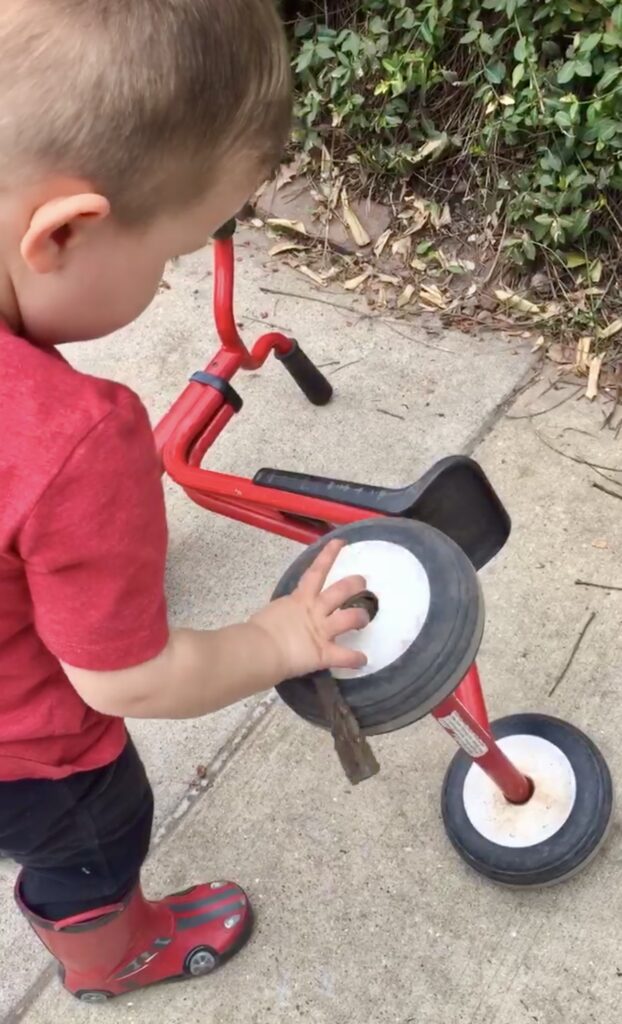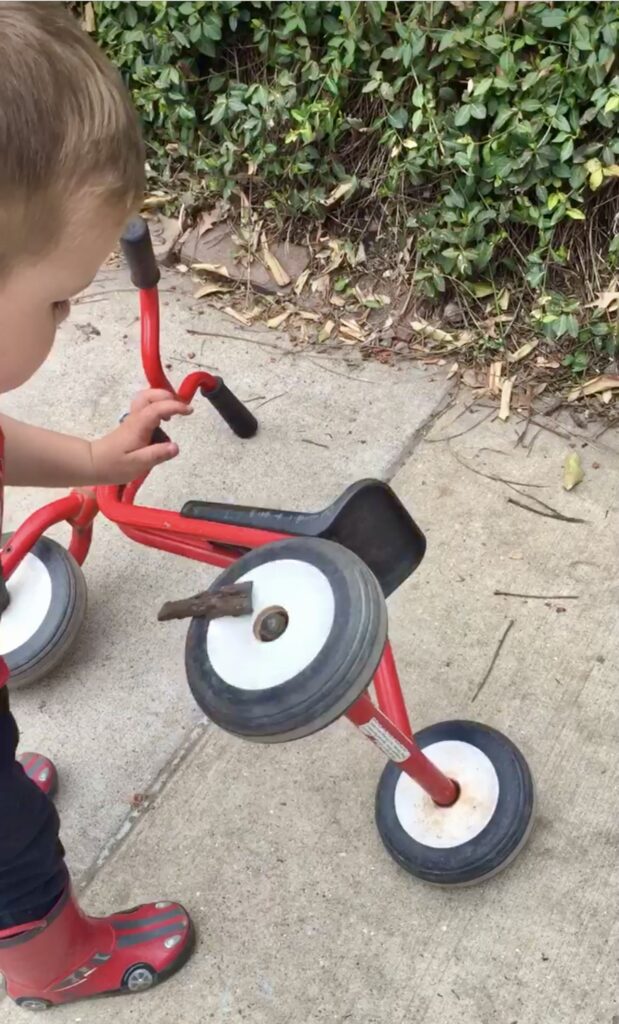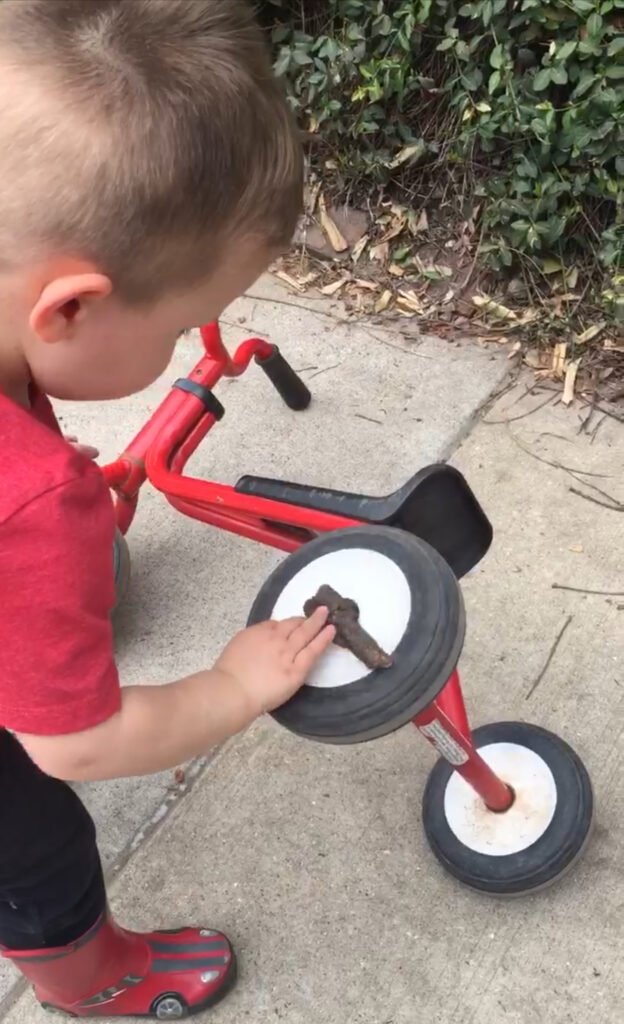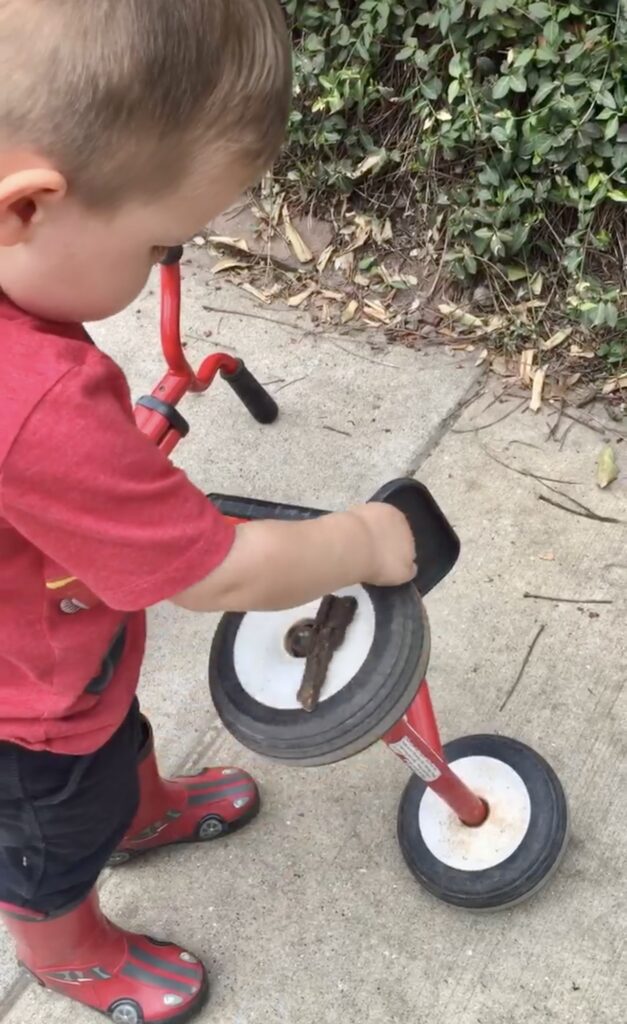Physics in Motion

Four-year-old Jordan is deep in thought and uncharacteristically quiet. When Jordan—one of our more rambunctious early learners—is this quiet, he is either sleeping or engaged in a scientific investigation.
I walk over to see what has captured his attention. Sure enough, Jordan is engaged in an impromptu physics experiment, which involves placing a piece of bark on the spinning wheel of a tipped-over tricycle.
How this tricycle landed on its side, where the bark came from, and how Jordan’s curiosity about movement and speed sparked this morning’s experiment will never be known. But his process of discovery and child-led learning would warm the heart of any early childhood educator!
I continue to observe as he begins to spin the wheel as fast as his right hand can push it. Then he drops the piece of bark onto the wheel with his left hand—only to watch it fly off of the wheel and onto the pavement.

Jordan reaches down to retrieve the bark. As he stands back up, he silently watches the spinning wheel.
Early childhood educators talk a lot about young children learning through their senses. Jordan’s investigation is a perfect example of this concept.
This hands-on investigation is a feast for the senses as Jordan feels the wheel move with each push of his hand, watches the bark fly off of the wheel, and hears the wheel squeak with each revolution.
Jordan starts to place the bark on the wheel again but stops himself as he remembers that he is trying to put the bark on a spinning wheel.
But how to keep the bark ON the wheel? Jordan is determined to figure this out.
First, he tries to figure out which technique he should use to rotate the wheel. He experiments with his left hand, then changes his mind and decides to use his right hand.
Then he engages in an exaggerated, comical warm-up, twisting and turning his small body with a rhythmic intensity to coax the wheel into a perfect spin. And it does spin. Fast!
And the bark falls off. Again and again.

Surprisingly, these setbacks don’t evoke the usual reactions such as frustration, anger, or impatience. Instead, they help build Jordan’s understanding of cause and effect in a very tangible way.
He spins the wheel from the left side, from the right side, and from the bottom, but the bark continues to fall off. By experimenting and observing, he’s developing skills in scientific inquiry.
After retrieving the bark for what feels like the zillionth time, Jordan places it on the still-spinning tire and presses it down just enough to keep the bark from sliding off—but not enough to stop the wheel from spinning.
Then he pauses, and I get the sense that he might be onto something. I’m not sure what Jordan’s goal is as he proceeds with his investigation, but this slight pause, accompanied by closer observation, leads me to believe that he may be in the process of solving the puzzle of the flying bark.

Jordan centers the bark on the tire once more and repeats his elaborate warm-up ritual.
He winds up to spin the wheel from the left but suddenly decides to rotate it from the right. The last-minute change of direction throws him off, and he misses his mark, but the back of his hand brushes lightly against the wheel and makes it spin—only this time, the wheel is spinning very slowly.

Wait, what? The bark is still sitting in the center of the tire!
I can almost see the “wheels spinning” in Jordan’s brain as he realizes that rotation speed influences the force of movement and the way that objects behave when they’re in motion.

Jordan is spellbound. He watches intently as the wheel slowly circles once, twice, three times. The bark is still in the center of the wheel!
But there is no time to celebrate because there is more data to gather. Jordan keeps his hand on the wheel and rotates it slowly, using his hand to control the spin.
The bark remains in the center of the wheel. And then he smiles. He’s figured it out!
Eureka! By varying the speed of the wheel, Jordan has discovered that the speed of the wheel’s rotation affects the movement of the bark. When the wheel spins faster, the force and speed make the bark fly off. When the wheel spins more slowly, the bark stays in place.
Jordan’s morning of scientific investigation has yielded valuable insights into several fundamental physics concepts, including rotation, friction, and the effect of speed on objects in motion. He has discovered that objects in motion tend to stay in motion and that an object’s attachment to a rotating surface is influenced by the speed of rotation.
This is a rudimentary understanding of Newton’s Laws of Motion and the concepts of inertia and centripetal force!

By asking questions, testing hypotheses, analyzing cause and effect, and observing outcomes, this precocious preschooler has taught himself about the laws of physics through hands-on play.
With all of this figured out, Jordan does exactly what we would expect him to do. He gives the wheel one more giant, grunting, screaming push that sends the bark flying.
Then, with a whoop of satisfaction, he flips the trike over, hops on, and pedals off at full speed to join his friends at play!
My students would love this.
awesome
Super cute activity
Cute lesson
Cute activity
Nice lesson. As a spin off from your lesson, I would place a leaf in water and see how far it will drift or float. We would chart and make drawings.
Oh Gloria, That’s a great idea! Thanks for sharing!
Loved this!
Very good idea
Nice!